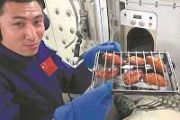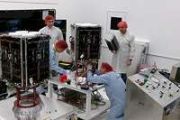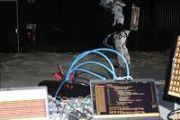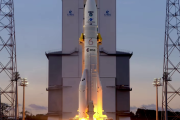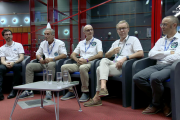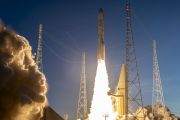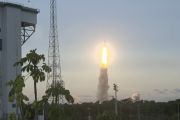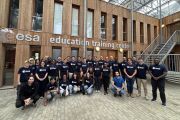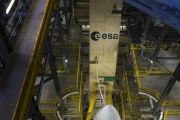
Copernical Team
Soundblasting a satellite – time-lapse of testing
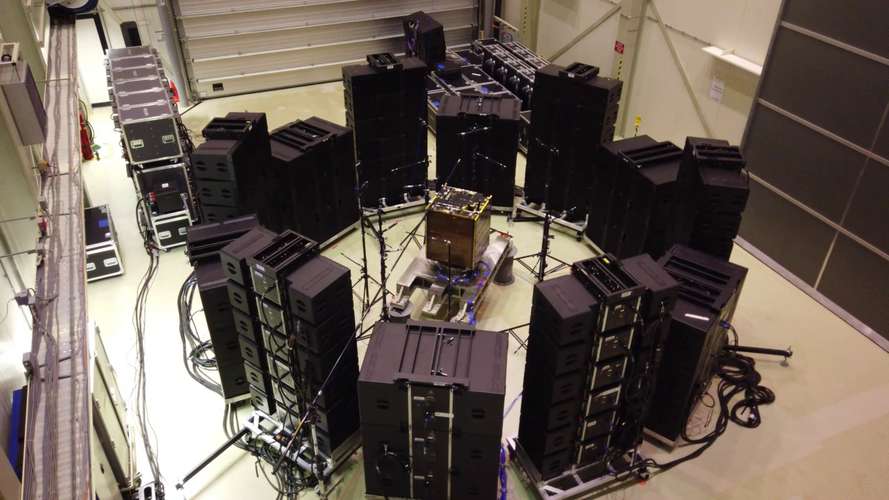 Video:
00:03:01
Video:
00:03:01
Verifying that a satellite will resist the sheer noise of the rocket launching it into orbit is a very important test that every mission must successfully pass.
“Typically satellites are tested inside purpose-built reverberant chambers, such as ESTEC’s own Large European Acoustic Facility sometimes described as the largest and most powerful sound system in Europe,” explains ESA test facility expert Steffen Scharfenberg, overseeing the test campaign together with ESA mechanical engineer Ivan Ngan. A very powerful noise generation system produces a uniform noise field thanks to the reverberation on the thick concrete walls of the chamber.
ESA has
Xplore and Keck Observatory announce innovative collaboration
 Xplore Inc., a commercial space company providing Space as a Service has announced a collaboration with the W. M. Keck Observatory in Waimea, Hawai'i. The Keck Observatory, the world's leading optical/infrared observatory, will assist Xplore in concept development and science case definition for the company's family of Xplore Space Telescopes (XST).
The XST series of commercial space teles
Xplore Inc., a commercial space company providing Space as a Service has announced a collaboration with the W. M. Keck Observatory in Waimea, Hawai'i. The Keck Observatory, the world's leading optical/infrared observatory, will assist Xplore in concept development and science case definition for the company's family of Xplore Space Telescopes (XST).
The XST series of commercial space teles Rapid increase in global light pollution
 Global light pollution has increased by at least 49% over 25 years, new research shows.
This figure only includes light visible via satellites, and scientists estimate the true increase may be significantly higher - up to 270% globally, and 400% in some regions.
The study, led by the University of Exeter, examined light emissions from 1992 to 2017.
The findings show differing r
Global light pollution has increased by at least 49% over 25 years, new research shows.
This figure only includes light visible via satellites, and scientists estimate the true increase may be significantly higher - up to 270% globally, and 400% in some regions.
The study, led by the University of Exeter, examined light emissions from 1992 to 2017.
The findings show differing r Better weather forecasting through satellite isotope data assimilation
 As the global climate continues to change and extreme weather events increasingly threaten regions all over the world, accurate weather forecasting is becoming more important than ever.
In a new study published in Scientific Reports, a research team led by Institute of Industrial Science, The University of Tokyo reports that weather forecast accuracy can be improved by several percentage p
As the global climate continues to change and extreme weather events increasingly threaten regions all over the world, accurate weather forecasting is becoming more important than ever.
In a new study published in Scientific Reports, a research team led by Institute of Industrial Science, The University of Tokyo reports that weather forecast accuracy can be improved by several percentage p Notre Dame to lead $25 million SpectrumX project; first NSF Spectrum Innovation Initiative Center
 The explosion of wireless applications enabled by advanced radio technologies has placed access to a key natural resource, the radio frequency spectrum, at a premium.
In the United States and around the world, radio frequencies are allocated to a variety of services such as mobile broadband, broadcasting and navigation (GPS) that are now mainstream and widely used. But the increasing deman
The explosion of wireless applications enabled by advanced radio technologies has placed access to a key natural resource, the radio frequency spectrum, at a premium.
In the United States and around the world, radio frequencies are allocated to a variety of services such as mobile broadband, broadcasting and navigation (GPS) that are now mainstream and widely used. But the increasing deman 'Many will follow': SpaceX sends all-civilian crew into orbit
 A SpaceX Falcon 9 rocket carrying four space tourists blasted off Wednesday night from the Kennedy Space Center in Florida for the first mission to orbit the globe with an all-civilian crew.
A huge fireball illuminated the sky as the rocket's nine engines began to pull away from Earth at 8:02 pm (0002 GMT Thursday).
Around 12 minutes later, the Dragon capsule separated from the rocket's
A SpaceX Falcon 9 rocket carrying four space tourists blasted off Wednesday night from the Kennedy Space Center in Florida for the first mission to orbit the globe with an all-civilian crew.
A huge fireball illuminated the sky as the rocket's nine engines began to pull away from Earth at 8:02 pm (0002 GMT Thursday).
Around 12 minutes later, the Dragon capsule separated from the rocket's Affordable housing in outer space: Scientists develop cosmic concrete from space dust and astronaut blood
 Transporting a single brick to Mars can cost more than a million British pounds - making the future construction of a Martian colony seem prohibitively expensive. Scientists at The University of Manchester have now developed a way to potentially overcome this problem, by creating a concrete-like material made of extra-terrestrial dust along with the blood, sweat and tears of astronauts.
In
Transporting a single brick to Mars can cost more than a million British pounds - making the future construction of a Martian colony seem prohibitively expensive. Scientists at The University of Manchester have now developed a way to potentially overcome this problem, by creating a concrete-like material made of extra-terrestrial dust along with the blood, sweat and tears of astronauts.
In A gem of a lab will bring the world of quantum physics into the light
 The novel design for a next-generation diamond sensor with capabilities that range from producing magnetic resonance imaging (MRI) of single molecules to detecting slight anomalies in the Earth's magnetic field to guide aircraft that lack access to global positioning systems (GPS) will be developed by a collaboration of scientists led by the U.S. Department of Energy's (DOE) Princeton Plasma Phy
The novel design for a next-generation diamond sensor with capabilities that range from producing magnetic resonance imaging (MRI) of single molecules to detecting slight anomalies in the Earth's magnetic field to guide aircraft that lack access to global positioning systems (GPS) will be developed by a collaboration of scientists led by the U.S. Department of Energy's (DOE) Princeton Plasma Phy NASA Lab studies sleepiness and use of automated systems
 Drowsy driving accounts for a large proportion of car crashes, according to the National Highway Traffic Safety Administration. So, you might think self-driving cars would fix that. After all, computers just don't get sleepy.
But today's vehicles are only partially automated, requiring the human driver to stay alert, monitor the road, and take over at a moment's notice. A new study conduct
Drowsy driving accounts for a large proportion of car crashes, according to the National Highway Traffic Safety Administration. So, you might think self-driving cars would fix that. After all, computers just don't get sleepy.
But today's vehicles are only partially automated, requiring the human driver to stay alert, monitor the road, and take over at a moment's notice. A new study conduct Chinese astronauts complete three-month space mission
 Three Chinese astronauts have completed the country's longest crewed mission and started their journey home on Thursday after 90 days at the Tiangong space station conducting spacewalks and scientific experiments.
"The Shenzhou-12 manned spacecraft has successfully separated from the space station's core module," state broadcaster CCTV said Thursday.
The mission was part of China's heavi
Three Chinese astronauts have completed the country's longest crewed mission and started their journey home on Thursday after 90 days at the Tiangong space station conducting spacewalks and scientific experiments.
"The Shenzhou-12 manned spacecraft has successfully separated from the space station's core module," state broadcaster CCTV said Thursday.
The mission was part of China's heavi 








